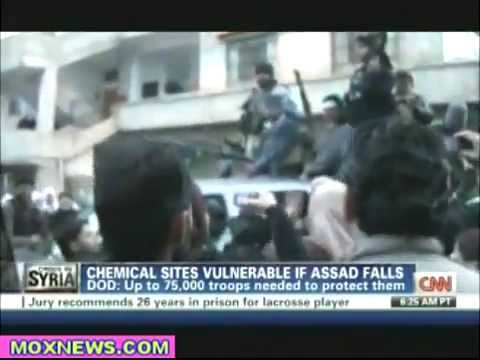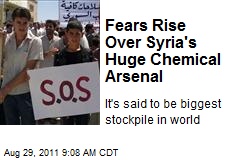
By Joby Warrick,
The Obama administration is accelerating its planning with Middle Eastern allies for a series of potentially fast-moving crises in Syria in the coming months, including the possible loss of government control over some of the country’s scattered stocks of chemical weapons, U.S. and Middle Eastern security officials say.
The planning, involving intelligence and military officials from at least seven countries, includes detailed arrangements for securing chemical arms with special operations troops in the event that parts of Syria are seized by militants, the officials said. Western and regional intelligence officials are increasingly concerned that Islamic extremists could attempt to seize control of whole towns and districts if the country slides into full-scale civil war.
The stepped-up preparations have coincided with increased military training in the region, including an unusually large multinational military exercise underway this month in Jordan, Syria’s southern neighbor. U.S. and Jordanian officials separately have been discussing possible permanent bases in the country for small units of Marines or special operations troops who could be deployed rapidly in a crisis anywhere in the region, from the Syria border to Iraq, according to current and former government officials familiar with the talks.
“There’s a big worry that things could fall apart quickly,” said a former U.S. intelligence official who has been briefed about the contingency plans and spoke on the condition of anonymity to discuss the diplomatically sensitive preparations. “A big problem can turn up on your doorstep overnight.”
Western intelligence agencies made similar plans to safeguard chemical munitions in Libya last year during the uprising there, particularly during the chaotic final weeks as Libyan troops deserted their bases ahead of the rebels’ final advance on Tripoli.
The Libyan arsenal, consisting mainly of bulk containers of degraded mustard agent, was deemed less dangerous than Syria’s battlefield-ready stock of more powerful nerve agents. Libya’s chemical weapons depots remained intact during the uprising, though thousands of other weapons of all kinds — from rocket-propelled grenades to shoulder-fired antiaircraft missiles — went missing.
While Syria’s arsenal of deadly nerve agents tops the list of worries, the planning group — which  has included elements of the CIA and Joint Special Operations Command on the U.S. side — also has sought to map out a response to other emergencies, from pilot-rescue operations to massive refugee flights to border violence as tribes along the Syrian frontier are drawn into skirmishes with government forces or rival groups, the officials said.
has included elements of the CIA and Joint Special Operations Command on the U.S. side — also has sought to map out a response to other emergencies, from pilot-rescue operations to massive refugee flights to border violence as tribes along the Syrian frontier are drawn into skirmishes with government forces or rival groups, the officials said.
“There are contingencies for everything, up to and including taking back a province that has been seized by al-Qaeda,” said a Middle Eastern intelligence official who has participated in the discussions.
While U.S. intelligence officials have conducted their own planning exercises for Syria, the increased coordination began early this year and intensified in recent months. An early advocate, Western diplomats say, was Jordan’s King Abdullah II, whose country has witnessed cross-border shootings in addition to masses of Syrian refugees since the uprising against Syrian President Bashar al-Assad began 14 months ago.
The process evolved into a series of bilateral discussions that grew to include Britain, Turkey, Israel, Saudi Arabia and the United Arab Emirates, according to two Middle Eastern security officials who have participated.
“We drew on the lessons from Libya,” the second Middle Eastern official said. “Some of the countries involved have overlapping air defenses, so on a practical level there has to be coordination.”
The contingency planning for securing Syrian chemical weapons relies on early warning from U.S. spy agencies who have been closely monitoring Assad’s stockpiles for more than a year. Syria possesses one of the world’s largest arsenals of chemical munitions, including tons of nerve gases such as VX and sarin, as well as artillery shells and missile warheads for delivering them.
The weapons are kept in bunkers under heavy guard in at least five sites around the country, weapons experts say. While the stockpiles appear secure at the moment, they could be plundered or simply abandoned if Syria troops are beaten back by increasingly well-armed rebels or by al-Qaeda-allied militants who have been streaming into the country from Iraq in recent weeks, intelligence officials say.
It is against this backdrop that military forces from 19 countries gathered in Jordan last week for a military exercise dubbed Eager Lion 2012. The exercise, focused primarily on special operations and counterinsurgency training, was expected to draw as many as 12,000 troops to the Jordanian desert, making it one of the largest exercises of its kind in the region, Pentagon officials said.
U.S. and Jordanian officials have declined to link the training exercise to the crisis in Syria, a country with which Jordan maintains diplomatic relations. But Pentagon officials involved in the event stressed the importance of “strategic theater cooperation” among special operations troops.
The training “does not target anyone — none of the neighboring or world countries,” Jordanian Armed Forces training chief Major Gen. Awni El-Edwan told reporters.
Washington Post
Leave a Reply
You must be logged in to post a comment.